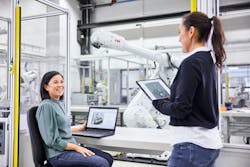Product News: ABB RobotStudio takes to the cloud enabling real-time collaboration
ABB's new RobotStudio Cloud promises to enable individuals and teams to collaborate in real-time on robot cell designs from anywhere in the world, on any device. New features, such as automatic version control, increase transparency and productivity across teams, per ABB. The software’s simplified interfaces and intuitive navigation enable users of all skill levels to work on robotic projects, claims its maker.
“At ABB Robotics, we continue to develop innovative and flexible solutions to help businesses overcome challenges, respond to changing customer needs and thrive in an age of increasing digitalization,” said Marc Segura, president of ABB Robotics division. “New web-based tools like RobotStudio Cloud bring a new level of agility and flexibility to manufacturers in how they plan and design their robotic automation solutions. Offering a simplified user experience, RobotStudio Cloud helps to increase collaboration and reduce complexity, enabling both novices and experts to push the boundaries of robotics programming.”
The new and enhanced cloud-based RobotStudio software can help companies program robots more collaboratively while cutting the time, cost and disruption associated with physical testing and commissioning. Now system integrators and engineering teams can collaborate in real-time to design, develop and enhance robotic automation solutions.
New features in RobotStudio Cloud include version control, which allows users to keep track of changes and have full transparency of any amendments. With complete knowledge of who edited the program and when, developers can cut the time needed to resolve errors and performance issues, notes ABB.
Incorporating RobotStudio’s cloud-based virtual controllers, developers have a rapid and powerful robot-simulation tool to tune and test programs. By producing an exact digital twin, the virtual controllers give developers complete confidence that—once installed in the real world—the robot will move as precisely as in the simulation, enabling fine-tuning and optimization that can help minimize waste or problems when production begins.
